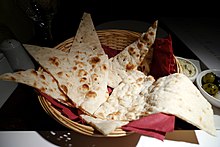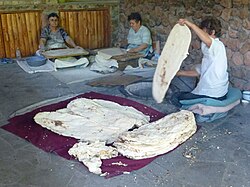 | |
| Type | Flatbread |
|---|---|
| Place of origin | Armenia[1][2][3][4][5] / Iran[6][7][8] |
| Region or state | West Asia |
| Serving temperature | Hot or cold |
| Lavash, the preparation, meaning and appearance of traditional bread as an expression of culture in Armenia | |
|---|---|
 Lavash making in Armenia | |
| Country | Armenia |
| Domains | Food |
| Reference | 985 |
| Region | Europe and North America |
| Inscription history | |
| Inscription | 2014 (9th session) |
| Flatbread making and sharing culture: Lavash, Katyrma, Jupka, Yufka | |
|---|---|
 | |
| Country | Iran, Kazakhstan and Kyrgyzstan |
| Domains | Food |
| Reference | 1181 |
| Region | Europe and North America |
| Inscription history | |
| Inscription | 2016 (11th session) |
Lavash (Armenian: լավաշ; Persian: نان لواش) is a thin flatbread[9] usually leavened, traditionally baked in a tandoor (tonir or tanoor) or on a sajj, and common to the cuisines of South Caucasus, West Asia, and the areas surrounding the Caspian Sea.[10][11][12] Lavash is one of the most widespread types of bread in Armenia, Azerbaijan, Iran and Turkey.[13] The traditional recipe can be adapted to the modern kitchen by using a griddle or wok instead of the tonir.[14]
In 2014, "Lavash, the preparation, meaning and appearance of traditional bread as an expression of culture in Armenia" was inscribed in the UNESCO Representative List of the Intangible Cultural Heritage of Humanity.[15] In 2016, making and sharing flatbread (lavash, katyrma, jupka or yufka) in communities of Azerbaijan, Iran, Kazakhstan, Kyrgyzstan and Turkey was inscribed on the list as well.[16] Lavash is similar to yufka, but in Turkish cuisine lavash (lavaş) is prepared with a yeast dough while yufka is typically unleavened.[17]
- ^ "Lavash". The American Heritage Dictionary.
- ^ Sergio O. Serna-Saldivar (2012). Cereal Grains: Laboratory Reference and Procedures Manual. CRC Press. p. 217. ISBN 9781439855652.
Lavash is another popular flat cracker bread with ancient roots in Armenia.
- ^ Albala, Ken (ed.). Food Cultures of the World Encyclopedia, Volume 1. Santa Barbara, California: Greenwood Press. p. 5. ISBN 9780313376269.
...on lavash, a traditional flatbread of Armenia similar to tortilla...
- ^ Goldstein, Darra (1999). A Taste of Russia: A Cookbook of Russian Hospitality (2nd ed.). Montpelier, VT: Russian Life Books. p. 185. ISBN 9781880100424.
Armenian Flat Bread Lavash: Lavash has been baked for centuries in Armenia.
- ^ Khanam, R. (2005). Encycl. Ethnography Of Middle-East And Central Asia (3 Vols. Set) (1st ed.). New Delhi: Global Vision. p. 55. ISBN 9788182200623.
The t'onir is a round hole dug in the ground, which can be used for baking Armenian flat bread (lavash) and for heating the home in winter.
- ^ Karizaki, Vahid Mohammadpour (2017-03-01). "Ethnic and traditional Iranian breads: different types, and historical and cultural aspects". Journal of Ethnic Foods. 4 (1): 8–14. doi:10.1016/j.jef.2017.01.002. ISSN 2352-6181.
The origin of lavash is most probably from Iran, according to the state of the encyclopedia of Jewish food.
- ^ Marks, Gil (2010). Encyclopedia of Jewish Food. Houghton Mifflin Harcourt. p. 355. ISBN 978-0470391303.
- ^ Reinhart, Peter (2011). The Bread Baker's Apprentice: Mastering the Art of Extraordinary Bread. Potter/TenSpeed/Harmony. p. 178. ISBN 978-1607741299.
Lavash, though usually called Armenian flatbread, also has Iranian roots (...)
- ^ Kipfer, Barbara Ann (2012-04-11). The Culinarian: A Kitchen Desk Reference. Houghton Mifflin Harcourt (published 2012). p. 334. ISBN 9780544186033. Retrieved 2015-06-01.
LAVASH, LAVOSH, LAHVOSH, LAWAASH, or LAWASHA, also called ARMENIAN CRACKER BREAD, CRACKER BREAD, or PARAKI, is a round, thin Middle Eastern bread that is soft like a tortilla or hard like a cracker.
- ^ Alan Davidson (1999). The Oxford Companion to Food. Oxford University Press. p. 456. ISBN 978-0192806819.
Lavash a thin crisp bread usually made with wheat flour made in a variety of shapes all over the regions of the South Caucasus, Iran (where it is often so thin as to be like tissue and can be almost seen through), and Afghanistan. It is leavened and baked in a tandoor. Lavash is served with kebabs and is used to scoop up food or wrap round food before being eaten. Its origins are ancient and it is also known as lavaş depending on the region. As in the other countries of this region large batches of this bread are made and stored for long periods. In Turkey they are stored on a board suspended by all four corners from the ceiling. The bread becomes dry and is restored by sprinkling with water and reheated as and when needed. Yufka is also a name for filo pastry.
- ^ Gil Marks (2010). Encyclopedia of Jewish Food. John Wiley and Sons. p. 355.
- ^ Morgan, Diane (2010). Skinny Dips. Chronicle Books. p. 14. ISBN 978-1452100241.
Lavash, lavosh, or lahvosh is a gigantic, paper-thin, blistery, tortilla-like flatbread common throughout Armenia, Turkey, and Iran.
- ^ "Tastes of Memory: How to Bake an Authentic Armenian Lavash". Smithsonian.
- ^ "Lavash". February 26, 2020.
- ^ "Lavash, the preparation, meaning and appearance of traditional bread as an expression of culture in Armenia, Inscribed in 2014 (9.COM) on the Representative List of the Intangible Cultural Heritage of Humanity. Country(ies): Armenia". unesco.org. Archived from the original on March 17, 2016. Retrieved 16 March 2016.
- ^ "Flatbread making and sharing culture: Lavash, Katyrma, Jupka, Yufka". unesco.org. Archived from the original on 1 December 2016. Retrieved 1 December 2016.
- ^ "İNCE EKMEK YAPMA VE PAYLAŞMA KÜLTÜRÜ". Kültür Portalı.